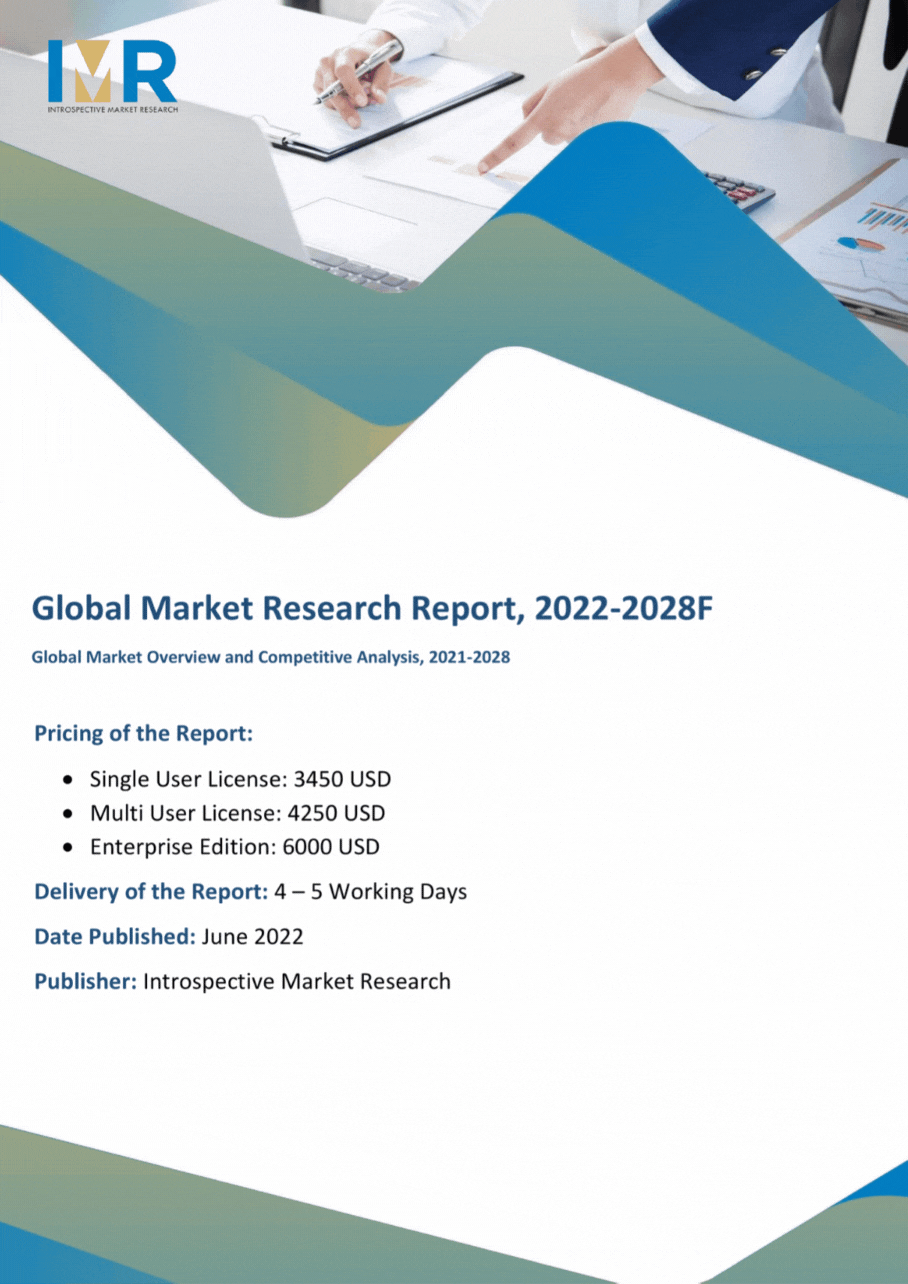Raw Meat Speciation Testing Market Synopsis
The raw Meat Speciation Testing Market Size Was Valued at USD 2.6 Billion in 2023, and is Projected to Reach USD 5.28 Billion by 2032, Growing at a CAGR of 8.2% From 2024-2032.
Raw meat speciation testing is a method that uses analytical techniques like DNA sequencing, PCR, and mass spectrometry to identify and authenticate meat species in food products. It ensures food safety, verifies labeling claims, and prevents fraud by detecting mislabelling or adulteration. It safeguards consumer health, maintains product integrity, and builds trust in the meat supply chain.
- Raw meat speciation testing is a vital method for ensuring the safety, authenticity, and compliance of meat products throughout the food supply chain. It verifies the species composition of raw meat products, ensuring they are accurately labeled and comply with regulatory standards. This helps prevent food fraud and mislabeling enhances food safety by detecting potential allergens, contaminants, or pathogens, and ensures compliance with regulations. Regulatory agencies also use speciation testing to enforce food safety regulations and monitor compliance.
- The food industry uses this method to verify product authenticity, ensure compliance, and protect consumer health. Government agencies use it to enforce food safety regulations and investigate cases of food fraud or mislabeling. Demand for speciation testing services and technologies is driven by strict regulations, consumer awareness, and the globalization of food supply chains. Technological advancements, such as DNA sequencing and PCR, have enhanced the speed, accuracy, and cost-effectiveness of speciation testing, driving market growth. The focus on food safety, quality assurance, and regulatory compliance is also driving companies to invest in speciation testing to meet consumer expectations and regulatory standards.
- The demand for rapid and portable speciation testing solutions is on the rise, enabling real-time monitoring throughout the food supply chain. This trend is driven by a shift towards proactive quality assurance and risk management practices. Advanced data analytics and AI technologies are also being adopted to analyze data, identify trends, and predict potential risks. These trends highlight the dynamic nature of the raw meat speciation testing market.

Raw Meat Speciation Testing Market Trend Analysis
Increasing Concerns About Food Fraud and Adulteration
- The adoption of raw meat speciation testing in the food industry is driven by growing concerns about food fraud and adulteration. Food fraud involves the deliberate substitution, addition, or misrepresentation of food products for economic gain, posing serious risks to consumer health, safety, and trust. High-profile cases of mislabeling, substitution, and adulteration have garnered widespread media attention, highlighting the need for robust testing methods to ensure product authenticity and integrity.
- Consumers are demanding greater transparency and assurance regarding the origin, composition, and quality of meat products, putting pressure on food manufacturers, retailers, and regulatory agencies to implement rigorous testing protocols. Globalization and the complex nature of modern food supply chains have exacerbated the risk of food fraud, making it easier for unscrupulous suppliers to introduce counterfeit or adulterated meat products into the market. Speciation testing provides a reliable means of verifying the species composition of raw meat products, helping to detect and deter fraudulent activities at various stages of the supply chain.
- The growing awareness of food fraud and adulteration is driving the demand for raw meat speciation testing, which is crucial for consumer health, trust in the food supply chain, and the integrity of meat products, highlighting the growing importance of robust species identification and authentication methods in the food industry.
Next-Generation Sequencing (NGS) Techniques
- Next-generation sequencing (NGS) is a high-throughput sequencing technique that offers a significant opportunity for advancing raw meat speciation testing. It enables the rapid and simultaneous sequencing of millions of DNA fragments, making it ideal for species identification in complex meat samples. NGS offers enhanced sensitivity and specificity, enabling the identification of multiple species present in a mixed or processed meat sample with high sensitivity and specificity. It also enables comprehensive species identification, allowing for the detection of a wide range of animal species, including closely related or similar species.
- NGS also facilitates quantitative analysis of species composition in meat samples, providing insights into the relative abundance of different species, which is valuable for assessing species adulteration or contamination and ensuring regulatory compliance in food labeling and traceability. NGS platforms offer high-throughput capabilities, allowing for simultaneous analysis of multiple samples in a cost-effective and time-efficient manner. Ongoing advancements in NGS technologies, such as improvements in sequencing chemistry, bioinformatics tools, and data analysis algorithms, continue to enhance the accuracy, speed, and affordability of raw meat speciation testing using NGS techniques.
Raw Meat Speciation Testing Market Segment Analysis:
Raw Meat Speciation Testing Market Segmented based on Type, Target Species, Testing Method, and End-User.
By Type, Polymerase Chain Reaction (PCR) segment is expected to dominate the market during the forecast period
- The polymerase chain reaction (PCR) segment is expected to dominate the raw meat speciation testing market due to its superior accuracy, sensitivity, and versatility. PCR offers unparalleled specificity in identifying target DNA sequences within meat samples, enabling precise detection and differentiation of species-specific DNA markers. This makes it the preferred choice for ensuring the authenticity and integrity of meat products. PCR assays can be customized to target specific genetic markers associated with different meat species, enhancing throughput and efficiency in species identification.
- Real-time PCR (qPCR) platforms offer rapid and quantitative analysis of DNA targets, providing valuable insights into the relative abundance of different species and facilitating quantitative species identification and characterization. PCR-based methods are widely adopted across various end-user segments in the meat industry, including food processors, manufacturers, retailers, government regulatory bodies, and religious organizations. The versatility and reliability of PCR make it suitable for a diverse range of applications, from routine quality control and compliance testing in food processing facilities to regulatory monitoring and enforcement by government agencies.
By Testing Method, DNA-Based Testing segment is expected to dominate the market during the forecast period
- The DNA-Based Testing segment, particularly Polymerase Chain Reaction (PCR) and related techniques is expected to dominate the raw meat speciation testing market due to its numerous advantages and widespread applicability across various meat industry sectors. DNA-Based Testing offers unmatched specificity and accuracy in identifying species-specific DNA markers in meat samples, ensuring precise species identification even in complex matrices or processed meat products. This makes it effective in detecting species adulteration, contamination, or mislabeling, ensuring the authenticity and integrity of meat products.
- DNA-Based Testing methods, such as PCR, real-time PCR (qPCR), and DNA sequencing, offer unparalleled sensitivity, enabling the detection of trace amounts of target DNA molecules present in meat samples at low concentrations. This sensitivity enhances the capability to identify species even in highly processed or mixed meat products. DNA-Based Testing is highly versatile and customizable, allowing for the development of multiplex assays capable of simultaneously detecting multiple target species within a single sample. DNA-Based Testing is widely accepted and endorsed by regulatory agencies and industry stakeholders as the gold standard for species identification in the meat industry.
Raw Meat Speciation Testing Market Regional Insights:
Asia Pacific is Expected to Dominate the Market Over the Forecast period
- The Asia Pacific region is poised to dominate the raw meat speciation testing market due to its significant role in the global meat industry. The region's burgeoning population, rapid urbanization, and rising disposable incomes have led to increased meat consumption, driving demand for robust quality control measures and speciation testing to ensure food safety and authenticity. The region has also witnessed a surge in food safety concerns and regulatory initiatives aimed at enhancing food quality and traceability.
- Governments across the region are implementing stringent regulations and standards for meat processing, labeling, and distribution, mandating the use of speciation testing to verify the accuracy of meat products' species composition. The globalization of food supply chains and the expansion of international trade have heightened the need for reliable speciation testing in the Asia Pacific region. Rapid technological advancements and investments in research and development are driving innovation in raw meat speciation testing methods and technologies.
Raw Meat Speciation Testing Market Top Key Players:
- Merieux NutriSciences Corporation (US)
- Genetic ID NA, Inc. (US)
- FoodChain ID (US)
- Neogen Corporation (US)
- Microbac Laboratories, Inc. (US)
- AB Sciex LLC (US)
- Thermo Fisher Scientific Inc. (US)
- PerkinElmer Inc. (US)
- Waters Corporation (US)
- Agilent Technologies, Inc. (US)
- ELISA Technologies, Inc. (US)
- EnviroLogix Inc. (US)
- InstantLabs Medical Diagnostics Corporation (US)
- Intertek Group plc (UK)
- LGC Limited (UK)
- Randox Laboratories Ltd. (UK)
- SGS SA (Switzerland)
- Bureau Veritas SA (France)
- QIAGEN N.V. (Netherlands)
- Eurofins Scientific SE (Luxembourg)
- Romer Labs, Inc. (Austria)
- Eurofins Technologies (Belgium)
- Foss A/S (Denmark)
- ALS Limited (Australia)
- Shimadzu Corporation (Japan), and Other Major Players.
Key Industry Developments in the Raw Meat Speciation Testing Market:
- In April 2023, International Laboratory Services (ILS) made a substantial advancement in bolstering the credibility of meat product testing by embracing a new ISO 17025-accredited technique for species identification. Adopting this innovative methodology underscores ILS's steadfast dedication to maintaining the utmost precision and dependability in its analytical services.
- In January 2023, Eurofins Scientific, a renowned figure in bioanalytical testing worldwide, unveiled a pioneering partnership with the University of Vienna to spearhead a state-of-the-art DNA sequencing approach for improved species identification in meat products.
|
Global Raw Meat Speciation Testing Market |
|||
|
Base Year: |
2023 |
Forecast Period: |
2024-2032 |
|
Historical Data: |
2017 to 2023 |
Market Size in 2023: |
USD 2.6 Bn. |
|
Forecast Period 2024-32 CAGR: |
8.2 % |
Market Size in 2032: |
USD 5.28 Bn. |
|
Segments Covered: |
By Type |
|
|
|
By Target Species |
|
||
|
By Testing Method |
|
||
|
By End-User |
|
||
|
By Region |
|
||
|
Key Market Drivers: |
|
||
|
Key Market Restraints: |
|
||
|
Key Opportunities: |
|
||
|
Companies Covered in the Report: |
|
||
- INTRODUCTION
- RESEARCH OBJECTIVES
- RESEARCH METHODOLOGY
- RESEARCH PROCESS
- SCOPE AND COVERAGE
- Market Definition
- Key Questions Answered
- MARKET SEGMENTATION
- EXECUTIVE SUMMARY
- MARKET OVERVIEW
- GROWTH OPPORTUNITIES BY SEGMENT
- MARKET LANDSCAPE
- PORTER’S FIVE FORCES ANALYSIS
- Bargaining Power Of Supplier
- Threat Of New Entrants
- Threat Of Substitutes
- Competitive Rivalry
- Bargaining Power Among Buyers
- INDUSTRY VALUE CHAIN ANALYSIS
- MARKET DYNAMICS
- Drivers
- Restraints
- Opportunities
- Challenges
- MARKET TREND ANALYSIS
- REGULATORY LANDSCAPE
- PESTLE ANALYSIS
- PRICE TREND ANALYSIS
- PATENT ANALYSIS
- TECHNOLOGY EVALUATION
- MARKET IMPACT OF THE RUSSIA-UKRAINE WAR
- Geopolitical Market Disruptions
- Supply Chain Disruptions
- Instability in Emerging Markets
- ECOSYSTEM
- PORTER’S FIVE FORCES ANALYSIS
- RAW MEAT SPECIATION TESTING MARKET BY TYPE (2017-2032)
- RAW MEAT SPECIATION TESTING MARKET SNAPSHOT AND GROWTH ENGINE
- MARKET OVERVIEW
- POLYMERASE CHAIN REACTION (PCR)
- Introduction And Market Overview
- Historic And Forecasted Market Size in Value (2017 – 2032F)
- Historic And Forecasted Market Size in Volume (2017 – 2032F)
- Key Market Trends, Growth Factors And Opportunities
- Geographic Segmentation Analysis
- ENZYME-LINKED IMMUNOSORBENT ASSAY (ELISA)
- REAL-TIME PCR (QPCR)
- MASS SPECTROMETRY
- RAW MEAT SPECIATION TESTING MARKET BY TARGET SPECIES (2017-2032)
- RAW MEAT SPECIATION TESTING MARKET SNAPSHOT AND GROWTH ENGINE
- MARKET OVERVIEW
- BEEF
- Introduction And Market Overview
- Historic And Forecasted Market Size in Value (2017 – 2032F)
- Historic And Forecasted Market Size in Volume (2017 – 2032F)
- Key Market Trends, Growth Factors And Opportunities
- Geographic Segmentation Analysis
- PORK
- CHICKEN
- LAMB
- TURKEY
- RAW MEAT SPECIATION TESTING MARKET BY TESTING METHOD (2017-2032)
- RAW MEAT SPECIATION TESTING MARKET SNAPSHOT AND GROWTH ENGINE
- MARKET OVERVIEW
- DNA-BASED TESTING
- Introduction And Market Overview
- Historic And Forecasted Market Size in Value (2017 – 2032F)
- Historic And Forecasted Market Size in Volume (2017 – 2032F)
- Key Market Trends, Growth Factors And Opportunities
- Geographic Segmentation Analysis
- PROTEIN-BASED TESTING
- RAW MEAT SPECIATION TESTING MARKET BY END-USER (2017-2032)
- RAW MEAT SPECIATION TESTING MARKET SNAPSHOT AND GROWTH ENGINE
- MARKET OVERVIEW
- FOOD PROCESSORS AND MANUFACTURERS
- Introduction And Market Overview
- Historic And Forecasted Market Size in Value (2017 – 2032F)
- Historic And Forecasted Market Size in Volume (2017 – 2032F)
- Key Market Trends, Growth Factors And Opportunities
- Geographic Segmentation Analysis
- RETAILERS AND DISTRIBUTORS
- GOVERNMENT REGULATORY BODIES
- RELIGIOUS ORGANIZATIONS
- COMPANY PROFILES AND COMPETITIVE ANALYSIS
- COMPETITIVE LANDSCAPE
- Competitive Positioning
- Raw Meat Speciation Testing Market Share By Manufacturer (2023)
- Industry BCG Matrix
- Heat Map Analysis
- Mergers & Acquisitions
- MERIEUX NUTRISCIENCES CORPORATION (US)
- Company Overview
- Key Executives
- Company Snapshot
- Role of the Company in the Market
- Sustainability and Social Responsibility
- Operating Business Segments
- Product Portfolio
- Business Performance (Production Volume, Sales Volume, Sales Margin, Production Capacity, Capacity Utilization Rate)
- Key Strategic Moves And Recent Developments
- SWOT Analysis
- GENETIC ID NA, INC. (US)
- FOODCHAIN ID (US)
- NEOGEN CORPORATION (US)
- MICROBAC LABORATORIES, INC. (US)
- AB SCIEX LLC (US)
- THERMO FISHER SCIENTIFIC INC. (US)
- PERKINELMER INC. (US)
- WATERS CORPORATION (US)
- AGILENT TECHNOLOGIES, INC. (US)
- ELISA TECHNOLOGIES, INC. (US)
- ENVIROLOGIX INC. (US)
- INSTANTLABS MEDICAL DIAGNOSTICS CORPORATION (US)
- INTERTEK GROUP PLC (UK)
- LGC LIMITED (UK)
- RANDOX LABORATORIES LTD. (UK)
- SGS SA (SWITZERLAND)
- BUREAU VERITAS SA (FRANCE)
- QIAGEN N.V. (NETHERLANDS)
- EUROFINS SCIENTIFIC SE (LUXEMBOURG)
- ROMER LABS, INC. (AUSTRIA)
- EUROFINS TECHNOLOGIES (BELGIUM)
- FOSS A/S (DENMARK)
- ALS LIMITED (AUSTRALIA)
- SHIMADZU CORPORATION (JAPAN)
- COMPETITIVE LANDSCAPE
- GLOBAL RAW MEAT SPECIATION TESTING MARKET BY REGION
- OVERVIEW
- NORTH AMERICA
- Key Market Trends, Growth Factors And Opportunities
- Key Manufacturers
- Historic And Forecasted Market Size By Type
- Historic And Forecasted Market Size By Target Species
- Historic And Forecasted Market Size By Testing Method
- Historic And Forecasted Market Size By End-User
- Historic And Forecasted Market Size By Country
- USA
- Canada
- Mexico
- EASTERN EUROPE
- Key Market Trends, Growth Factors And Opportunities
- Key Manufacturers
- Historic And Forecasted Market Size By Segments
- Historic And Forecasted Market Size By Country
- Russia
- Bulgaria
- The Czech Republic
- Hungary
- Poland
- Romania
- Rest Of Eastern Europe
- WESTERN EUROPE
- Key Market Trends, Growth Factors And Opportunities
- Key Manufacturers
- Historic And Forecasted Market Size By Segments
- Historic And Forecasted Market Size By Country
- Germany
- United Kingdom
- France
- The Netherlands
- Italy
- Spain
- Rest Of Western Europe
- ASIA PACIFIC
- Key Market Trends, Growth Factors And Opportunities
- Key Manufacturers
- Historic And Forecasted Market Size By Segments
- Historic And Forecasted Market Size By Country
- China
- India
- Japan
- South Korea
- Malaysia
- Thailand
- Vietnam
- The Philippines
- Australia
- New-Zealand
- Rest Of APAC
- MIDDLE EAST & AFRICA
- Key Market Trends, Growth Factors And Opportunities
- Key Manufacturers
- Historic And Forecasted Market Size By Segments
- Historic And Forecasted Market Size By Country
- Turkey
- Bahrain
- Kuwait
- Saudi Arabia
- Qatar
- UAE
- Israel
- South Africa
- SOUTH AMERICA
- Key Market Trends, Growth Factors And Opportunities
- Key Manufacturers
- Historic And Forecasted Market Size By Segments
- Historic And Forecasted Market Size By Country
- Brazil
- Argentina
- Rest of South America
- INVESTMENT ANALYSIS
- ANALYST VIEWPOINT AND CONCLUSION
- Recommendations and Concluding Analysis
- Potential Market Strategies
|
Global Raw Meat Speciation Testing Market |
|||
|
Base Year: |
2023 |
Forecast Period: |
2024-2032 |
|
Historical Data: |
2017 to 2023 |
Market Size in 2023: |
USD 2.6 Bn. |
|
Forecast Period 2024-32 CAGR: |
8.2 % |
Market Size in 2032: |
USD 5.28 Bn. |
|
Segments Covered: |
By Type |
|
|
|
By Target Species |
|
||
|
By Testing Method |
|
||
|
By End-User |
|
||
|
By Region |
|
||
|
Key Market Drivers: |
|
||
|
Key Market Restraints: |
|
||
|
Key Opportunities: |
|
||
|
Companies Covered in the Report: |
|
||
LIST OF TABLES
TABLE 001. EXECUTIVE SUMMARY
TABLE 002. RAW MEAT SPECIATION TESTING MARKET BARGAINING POWER OF SUPPLIERS
TABLE 003. RAW MEAT SPECIATION TESTING MARKET BARGAINING POWER OF CUSTOMERS
TABLE 004. RAW MEAT SPECIATION TESTING MARKET COMPETITIVE RIVALRY
TABLE 005. RAW MEAT SPECIATION TESTING MARKET THREAT OF NEW ENTRANTS
TABLE 006. RAW MEAT SPECIATION TESTING MARKET THREAT OF SUBSTITUTES
TABLE 007. RAW MEAT SPECIATION TESTING MARKET BY TYPE
TABLE 008. PCR MARKET OVERVIEW (2016-2028)
TABLE 009. ELISA MARKET OVERVIEW (2016-2028)
TABLE 010. OTHER MOLECULAR DIAGNOSTIC TESTS MARKET OVERVIEW (2016-2028)
TABLE 011. RAW MEAT SPECIATION TESTING MARKET BY APPLICATION
TABLE 012. COW MARKET OVERVIEW (2016-2028)
TABLE 013. SWINE MARKET OVERVIEW (2016-2028)
TABLE 014. CHICKEN MARKET OVERVIEW (2016-2028)
TABLE 015. HORSE MARKET OVERVIEW (2016-2028)
TABLE 016. SHEEP MARKET OVERVIEW (2016-2028)
TABLE 017. NORTH AMERICA RAW MEAT SPECIATION TESTING MARKET, BY TYPE (2016-2028)
TABLE 018. NORTH AMERICA RAW MEAT SPECIATION TESTING MARKET, BY APPLICATION (2016-2028)
TABLE 019. N RAW MEAT SPECIATION TESTING MARKET, BY COUNTRY (2016-2028)
TABLE 020. EUROPE RAW MEAT SPECIATION TESTING MARKET, BY TYPE (2016-2028)
TABLE 021. EUROPE RAW MEAT SPECIATION TESTING MARKET, BY APPLICATION (2016-2028)
TABLE 022. RAW MEAT SPECIATION TESTING MARKET, BY COUNTRY (2016-2028)
TABLE 023. ASIA PACIFIC RAW MEAT SPECIATION TESTING MARKET, BY TYPE (2016-2028)
TABLE 024. ASIA PACIFIC RAW MEAT SPECIATION TESTING MARKET, BY APPLICATION (2016-2028)
TABLE 025. RAW MEAT SPECIATION TESTING MARKET, BY COUNTRY (2016-2028)
TABLE 026. MIDDLE EAST & AFRICA RAW MEAT SPECIATION TESTING MARKET, BY TYPE (2016-2028)
TABLE 027. MIDDLE EAST & AFRICA RAW MEAT SPECIATION TESTING MARKET, BY APPLICATION (2016-2028)
TABLE 028. RAW MEAT SPECIATION TESTING MARKET, BY COUNTRY (2016-2028)
TABLE 029. SOUTH AMERICA RAW MEAT SPECIATION TESTING MARKET, BY TYPE (2016-2028)
TABLE 030. SOUTH AMERICA RAW MEAT SPECIATION TESTING MARKET, BY APPLICATION (2016-2028)
TABLE 031. RAW MEAT SPECIATION TESTING MARKET, BY COUNTRY (2016-2028)
TABLE 032. VWR INTERNATIONAL LLC: SNAPSHOT
TABLE 033. VWR INTERNATIONAL LLC: BUSINESS PERFORMANCE
TABLE 034. VWR INTERNATIONAL LLC: PRODUCT PORTFOLIO
TABLE 035. VWR INTERNATIONAL LLC: KEY STRATEGIC MOVES AND DEVELOPMENTS
TABLE 035. EUROFINS SCIENTIFIC SE: SNAPSHOT
TABLE 036. EUROFINS SCIENTIFIC SE: BUSINESS PERFORMANCE
TABLE 037. EUROFINS SCIENTIFIC SE: PRODUCT PORTFOLIO
TABLE 038. EUROFINS SCIENTIFIC SE: KEY STRATEGIC MOVES AND DEVELOPMENTS
TABLE 038. ALS LIMITED: SNAPSHOT
TABLE 039. ALS LIMITED: BUSINESS PERFORMANCE
TABLE 040. ALS LIMITED: PRODUCT PORTFOLIO
TABLE 041. ALS LIMITED: KEY STRATEGIC MOVES AND DEVELOPMENTS
TABLE 041. IEH LABORATORIES AND CONSULTING GROUP: SNAPSHOT
TABLE 042. IEH LABORATORIES AND CONSULTING GROUP: BUSINESS PERFORMANCE
TABLE 043. IEH LABORATORIES AND CONSULTING GROUP: PRODUCT PORTFOLIO
TABLE 044. IEH LABORATORIES AND CONSULTING GROUP: KEY STRATEGIC MOVES AND DEVELOPMENTS
TABLE 044. MÉRIEUX NUTRISCIENCES: SNAPSHOT
TABLE 045. MÉRIEUX NUTRISCIENCES: BUSINESS PERFORMANCE
TABLE 046. MÉRIEUX NUTRISCIENCES: PRODUCT PORTFOLIO
TABLE 047. MÉRIEUX NUTRISCIENCES: KEY STRATEGIC MOVES AND DEVELOPMENTS
TABLE 047. BIO-CHECK: SNAPSHOT
TABLE 048. BIO-CHECK: BUSINESS PERFORMANCE
TABLE 049. BIO-CHECK: PRODUCT PORTFOLIO
TABLE 050. BIO-CHECK: KEY STRATEGIC MOVES AND DEVELOPMENTS
TABLE 050. EMPORT LLC: SNAPSHOT
TABLE 051. EMPORT LLC: BUSINESS PERFORMANCE
TABLE 052. EMPORT LLC: PRODUCT PORTFOLIO
TABLE 053. EMPORT LLC: KEY STRATEGIC MOVES AND DEVELOPMENTS
TABLE 053. EMSL ANALYTICAL INC.: SNAPSHOT
TABLE 054. EMSL ANALYTICAL INC.: BUSINESS PERFORMANCE
TABLE 055. EMSL ANALYTICAL INC.: PRODUCT PORTFOLIO
TABLE 056. EMSL ANALYTICAL INC.: KEY STRATEGIC MOVES AND DEVELOPMENTS
TABLE 056. NEOGEN: SNAPSHOT
TABLE 057. NEOGEN: BUSINESS PERFORMANCE
TABLE 058. NEOGEN: PRODUCT PORTFOLIO
TABLE 059. NEOGEN: KEY STRATEGIC MOVES AND DEVELOPMENTS
TABLE 059. BUREAU VERITAS: SNAPSHOT
TABLE 060. BUREAU VERITAS: BUSINESS PERFORMANCE
TABLE 061. BUREAU VERITAS: PRODUCT PORTFOLIO
TABLE 062. BUREAU VERITAS: KEY STRATEGIC MOVES AND DEVELOPMENTS
TABLE 062. SGS: SNAPSHOT
TABLE 063. SGS: BUSINESS PERFORMANCE
TABLE 064. SGS: PRODUCT PORTFOLIO
TABLE 065. SGS: KEY STRATEGIC MOVES AND DEVELOPMENTS
TABLE 065. OTHER MAJOR PLAYERS: SNAPSHOT
TABLE 066. OTHER MAJOR PLAYERS: BUSINESS PERFORMANCE
TABLE 067. OTHER MAJOR PLAYERS: PRODUCT PORTFOLIO
TABLE 068. OTHER MAJOR PLAYERS: KEY STRATEGIC MOVES AND DEVELOPMENTS
LIST OF FIGURES
FIGURE 001. YEARS CONSIDERED FOR ANALYSIS
FIGURE 002. SCOPE OF THE STUDY
FIGURE 003. RAW MEAT SPECIATION TESTING MARKET OVERVIEW BY REGIONS
FIGURE 004. PORTER'S FIVE FORCES ANALYSIS
FIGURE 005. BARGAINING POWER OF SUPPLIERS
FIGURE 006. COMPETITIVE RIVALRYFIGURE 007. THREAT OF NEW ENTRANTS
FIGURE 008. THREAT OF SUBSTITUTES
FIGURE 009. VALUE CHAIN ANALYSIS
FIGURE 010. PESTLE ANALYSIS
FIGURE 011. RAW MEAT SPECIATION TESTING MARKET OVERVIEW BY TYPE
FIGURE 012. PCR MARKET OVERVIEW (2016-2028)
FIGURE 013. ELISA MARKET OVERVIEW (2016-2028)
FIGURE 014. OTHER MOLECULAR DIAGNOSTIC TESTS MARKET OVERVIEW (2016-2028)
FIGURE 015. RAW MEAT SPECIATION TESTING MARKET OVERVIEW BY APPLICATION
FIGURE 016. COW MARKET OVERVIEW (2016-2028)
FIGURE 017. SWINE MARKET OVERVIEW (2016-2028)
FIGURE 018. CHICKEN MARKET OVERVIEW (2016-2028)
FIGURE 019. HORSE MARKET OVERVIEW (2016-2028)
FIGURE 020. SHEEP MARKET OVERVIEW (2016-2028)
FIGURE 021. NORTH AMERICA RAW MEAT SPECIATION TESTING MARKET OVERVIEW BY COUNTRY (2016-2028)
FIGURE 022. EUROPE RAW MEAT SPECIATION TESTING MARKET OVERVIEW BY COUNTRY (2016-2028)
FIGURE 023. ASIA PACIFIC RAW MEAT SPECIATION TESTING MARKET OVERVIEW BY COUNTRY (2016-2028)
FIGURE 024. MIDDLE EAST & AFRICA RAW MEAT SPECIATION TESTING MARKET OVERVIEW BY COUNTRY (2016-2028)
FIGURE 025. SOUTH AMERICA RAW MEAT SPECIATION TESTING MARKET OVERVIEW BY COUNTRY (2016-2028)
Frequently Asked Questions :
The forecast period in the Raw Meat Speciation Testing Market research report is 2024-2032.
Merieux NutriSciences Corporation (US), Genetic ID NA, Inc. (US), FoodChain ID (US), Neogen Corporation (US), Microbac Laboratories, Inc. (US), AB Sciex LLC (US), Thermo Fisher Scientific Inc. (US), PerkinElmer Inc. (US), Waters Corporation (US), Agilent Technologies, Inc. (US), ELISA Technologies, Inc. (US), EnviroLogix Inc. (US), InstantLabs Medical Diagnostics Corporation (US), Intertek Group plc (UK), LGC Limited (UK), Randox Laboratories Ltd. (UK), SGS SA (Switzerland), Bureau Veritas SA (France), QIAGEN N.V. (Netherlands), Eurofins Scientific SE (Luxembourg), Romer Labs, Inc. (Austria), Eurofins Technologies (Belgium), Foss A/S (Denmark), ALS Limited (Australia), Shimadzu Corporation (Japan) and Other Major Players.
The Raw Meat Speciation Testing Market is segmented into Type, Target Species, Testing Method, End-User, and region. By Type, the market is categorized into Polymerase Chain Reaction (PCR), Enzyme-Linked Immunosorbent Assay (ELISA), Real-Time PCR (qPCR), and Mass Spectrometry. By Target Species, the market is categorized into Beef, Pork, Chicken, Lamb, and Turkey. By Testing Method, the market is categorized into DNA-based testing and protein-based Testing. By End-User, the market is categorized into Food Processors and Manufacturers, Retailers and Distributors, Government Regulatory Bodies, and Religious Organizations. By region, it is analyzed across North America (U.S.; Canada; Mexico), Eastern Europe (Bulgaria; The Czech Republic; Hungary; Poland; Romania; Rest of Eastern Europe), Western Europe (Germany; UK; France; Netherlands; Italy; Russia; Spain; Rest of Western Europe), Asia-Pacific (China; India; Japan; Southeast Asia, etc.), South America (Brazil; Argentina, etc.), Middle East & Africa (Saudi Arabia; South Africa, etc.).
Raw meat speciation testing is a method that uses analytical techniques like DNA sequencing, PCR, and mass spectrometry to identify and authenticate meat species in food products. It ensures food safety, verifies labeling claims, and prevents fraud by detecting mislabeling or adulteration. It safeguards consumer health, maintains product integrity, and builds trust in the meat supply chain.
The raw Meat Speciation Testing Market Size Was Valued at USD 2.6 Billion in 2023, and is Projected to Reach USD 5.28 Billion by 2032, Growing at a CAGR of 8.2% From 2024-2032.


































